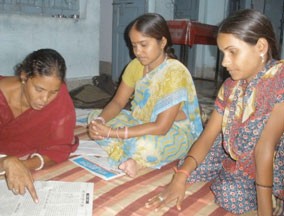Newspaper For Women, By Women in India
A recent article published in the women-run newspaper, Khabar Lahariya, revealed that rural women in Chitrakoot, a district in the north India state of Uttar Pradesh, aren’t getting emergency care in their local hospital. The reporter questioned the doctors on duty about the situation. While the article didn’t lead to an immediate solution to the problem, it was notable for being published at all. The fact that the newspaper treated women’s health care as a matter of worth reporting is what makes Khabar Lahariya distinctive.
 Poverty, illiteracy and gender discrimination are commonplace in Chitrakoot and the rest of Uttar Pradesh. The male-dominated social and economic system leaves little room for women’s news in the local media, much less an outlet for their views. Launched in 2002, Khabar Lahariya has given marginalized women an opportunity to produce media that highlights problems often overlooked by mainstream media outlets. This has helped improve literacy in the community because the women-oriented news focus of the paper means more women are reading the paper. The literacy of Khabar Lahariya’s staff has also improved, as the training and support they get, combined with writing and editing articles, leads to better reading and writing skills.
Poverty, illiteracy and gender discrimination are commonplace in Chitrakoot and the rest of Uttar Pradesh. The male-dominated social and economic system leaves little room for women’s news in the local media, much less an outlet for their views. Launched in 2002, Khabar Lahariya has given marginalized women an opportunity to produce media that highlights problems often overlooked by mainstream media outlets. This has helped improve literacy in the community because the women-oriented news focus of the paper means more women are reading the paper. The literacy of Khabar Lahariya’s staff has also improved, as the training and support they get, combined with writing and editing articles, leads to better reading and writing skills.
Khabar Lahariya is a completely women’s led-organization, with a staff of nearly a dozen women from the marginalized Dalit, Kol and Muslim communities. Written in the local language, it provides a mix of information, news and topics popular among its local readers. What distinguishes it from other newspapers, however, is the reporting on issues affecting women and impoverished people in Uttar Pradesh. For example, the newspaper covers incidents involving violence against women. Many of the women on staff have experienced abuse in the past and they find the opportunity to report on such topics empowering. Staff members have said in interviews that, because of the paper, besides being just someone’s daughter or wife, they have another identity: being a journalist.
Khabar Lahariya -- which means “News Waves” in Bundeli -- was conceived of by the New Delhi based Nirantar (https://www.nirantar.net/), a civic group specializing in gender, literacy and development issues. While the paper generates about 20 percent of its operating budget through sales, Nirantar covers the difference and also organizes the workshops necessary for its production.
Khabar Lahariya has a readership of more than 25,000 in approximately 400 villages in both the Chitrakoot and the Banda districts of Uttar Pradesh (it began publishing in Banda in 2006). The newspaper’s staff is paid between US$60 and US$140 per month. As women in this region, earning a wage gives the staff a sense of dignity. They say this has made them active participants in their family lives: They now make decisions regarding their children’s education and have money they can spend on themselves. They work to sell the newspaper and gather stories, often trekking up to places inaccessible by vehicles. They speak to local people and come back armed with new ideas for their weekly editorial meetings.
In India’s last election cycle, in 2009, this weekly newspaper began covering politics, traditionally a male domain. Many of the women on staff come from communities that have been left out of the democratic process, and they lacked the confidence to report on political issues. They didn’t believe they had the knowledge to write intelligently about issues like the proceedings leading to the 2009 parliamentary elections. Nirantar arranged for the editors and news staff to receive training about the political system and political reporting. As a result, the paper produced three special election editions that included interviews with local politicians and used language suited to the local readership to help them understand each politician’s platform.
Both within India and internationally, Khabar Lahariya has been recognized for its unique approach to newsgathering and literacy. In 2004, three members of the staff were awarded fellowships from the Dalit Foundation for reporting on issues related to the rights of the Dalit community. For these Dalit women, who have never been to school or left the limits of the district, this has meant the opening of doors that will help the entire community beat centuries of abuse and discrimination. In 2009, the paper won the United Nations Educational, Scientific and Cultural Organization (UNESCO) King Sejong Prize for Literacy, which praised the paper for its “method of training newly literate women as journalists and democratizing information production.”
In 2008, Khabar Lahariya was registered as an independent organization called “Pahal.” They are now trying to work independently of Nirantar (the organization that helped them get going) and therefore they are registering themselves as a new organization called “Pahal.”
While the paper does cover about 20 per cent of its operating budget through sales, Nirantar covers the difference and also organizes the workshops necessary for its production. Khabar Lahariya was registered as an independent organization called “Pahal” in 2008. With help from Nirantar, it is now working towards finding a niche as rural women’s media collectives in India.
Look at an edition at https://www.nirantar.net/khabar_slides.htm
Source: https://www.audiencescapes.org/newspaper-women-empowerment-india-khabar-Lahariya-UNESCO-award












